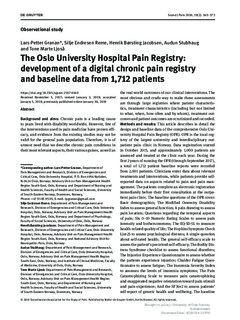| dc.contributor.author | Granan, Lars-Petter | |
| dc.contributor.author | Reme, Silje Endresen | |
| dc.contributor.author | Jacobsen, Henrik Børsting | |
| dc.contributor.author | Stubhaug, Audun | |
| dc.contributor.author | Ljoså, Tone Marte | |
| dc.date.accessioned | 2019-11-12T11:46:14Z | |
| dc.date.available | 2019-11-12T11:46:14Z | |
| dc.date.created | 2019-02-03T16:26:49Z | |
| dc.date.issued | 2019 | |
| dc.identifier.citation | Scandinavian Journal of Pain. 2019, 19 (2), 365-373. | nb_NO |
| dc.identifier.issn | 1877-8860 | |
| dc.identifier.uri | http://hdl.handle.net/11250/2627909 | |
| dc.description.abstract | Background and aims Chronic pain is a leading cause to years lived with disability worldwide. However, few of the interventions used in pain medicine have proven efficacy, and evidence from the existing studies may not be valid for the general pain population. Therefore, it is of utmost need that we describe chronic pain conditions in their most relevant aspects, their various guises, as well as the real world outcomes of our clinical interventions. The most obvious and crude way to make these assessments are through large registries where patient characteristics, treatment characteristics (including but not limited to what, when, how often and by whom), treatment outcomes and patient outcomes are scrutinized and recorded. Methods and results This article describes in detail the design and baseline data of the comprehensive Oslo University Hospital Pain Registry (OPR). OPR is the local registry of the largest university and interdisciplinary outpatient pain clinic in Norway. Data registration started in October 2015, and approximately 1,000 patients are assessed and treated at the clinic each year. During the first 2 years of running the OPR (through September 2017), a total of 1,712 patient baseline reports were recorded from 2,001 patients. Clinicians enter data about relevant treatments and interventions, while patients provide self-reported data on aspects related to pain and pain management. The patients complete an electronic registration immediately before their first consultation at the outpatient pain clinic. The baseline questions of the OPR cover: Basic demographics; The Modified Oswestry Disability Index to assess general function; A pain drawing to assess pain location; Questions regarding the temporal aspects of pain; Six 0–10 Numeric Rating Scales to assess pain intensity and bothersomeness; The EQ-5D-5L to measure health-related quality of life; The Hopkins Symptom Check List-25 to assess psychological distress; A single question about self-rated health; The general self-efficacy scale to assess the patient’s perceived self-efficacy; The Bodily Distress Syndrome checklist to assess functional disorders; The Injustice Experience Questionnaire to assess whether the patients experience injustice; Chalder Fatigue Questionnaire to assess fatigue; The Insomnia Severity Index to assesses the levels of insomnia symptoms; The Pain Catastrophizing Scale to measure pain catastrophizing and exaggerated negative orientation toward pain stimuli and pain experience; And the SF36v2 to assess patients’ self-report of generic health and wellbeing. The baseline data show that chronic pain patients have a high degree of negative impact in all aspects of their lives. Conclusions and implications The OPR is the most comprehensive pain registry for multidisciplinary and interdisciplinary outpatient pain clinics in Norway. Detailed design of the registry and key baseline data are presented. Registries are of great value in that they enable real world effectiveness outcomes for patients with chronic pain conditions. The OPR can thus serve as a model for similar initiatives elsewhere. The OPR cohort may also serve as a historical control in future studies, both with experimental and observational design. | nb_NO |
| dc.language.iso | eng | nb_NO |
| dc.title | The Oslo University Hospital Pain Registry: development of a digital chronic pain registry and baseline data from 1,712 patients | nb_NO |
| dc.type | Journal article | nb_NO |
| dc.type | Peer reviewed | nb_NO |
| dc.description.version | publishedVersion | nb_NO |
| dc.rights.holder | © 2019 Scandinavian Association for the Study of Pain | nb_NO |
| dc.source.pagenumber | 365-373 | nb_NO |
| dc.source.volume | 19 | nb_NO |
| dc.source.journal | Scandinavian Journal of Pain | nb_NO |
| dc.source.issue | 2 | nb_NO |
| dc.identifier.doi | 10.1515/sjpain-2017-0160 | |
| dc.identifier.cristin | 1672742 | |
| cristin.unitcode | 222,56,1,0 | |
| cristin.unitname | Institutt for sykepleie- og helsevitenskap | |
| cristin.ispublished | true | |
| cristin.fulltext | original | |
| cristin.qualitycode | 1 | |
